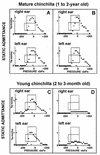Nasopharyngeal colonization with nontypeable Haemophilus influenzae in chinchillas
- PMID: 9573078
- PMCID: PMC108152
- DOI: 10.1128/IAI.66.5.1973-1980.1998
Nasopharyngeal colonization with nontypeable Haemophilus influenzae in chinchillas
Abstract
Colonization of the nasopharynx by a middle ear pathogen is the first step in the development of otitis media in humans. The establishment of an animal model of nasopharyngeal colonization would therefore be of great utility in assessing the potential protective ability of candidate vaccine antigens (especially adhesins) against otitis media. A chinchilla nasopharyngeal colonization model for nontypeable Haemophilus influenzae (NTHI) was developed with antibiotic-resistant strains. This model does not require coinfection with a virus. There was no significant difference in the efficiency of NTHI colonization between adult (1- to 2-year-old) and young (2- to 3-month-old) animals. However, the incidence of middle ear infection following nasopharyngeal colonization was significantly higher in young animals (83 to 89%) than in adult chinchillas (10 to 30%). Chinchillas that had recovered either from a previous middle ear infection caused by NTHI or from an infection by intranasal inoculation with NTHI were completely protected against nasopharyngeal colonization with a homologous strain and were found to be the best positive controls in protection studies. Systemic immunization of chinchillas with inactivated whole-cell preparations significantly protected animals not only against homologous NTHI colonization but also partially against heterologous NTHI infection. In all protected animals, significant serum anti-P6 and anti-HMW antibody responses were observed. The outer membrane P6 and high-molecular-weight (HMW) proteins appear to be promising candidate vaccine antigens to prevent nasopharyngeal colonization and middle ear infection caused by NTHI.
Figures




Similar articles
-
Immunization with outer membrane protein P6 from nontypeable Haemophilus influenzae induces bactericidal antibody and affords protection in the chinchilla model of otitis media.Infect Immun. 1996 Dec;64(12):5187-92. doi: 10.1128/iai.64.12.5187-5192.1996. Infect Immun. 1996. PMID: 8945564 Free PMC article.
-
Immunogenicity of Nontypeable Haemophilus influenzae Outer Membrane Vesicles and Protective Ability in the Chinchilla Model of Otitis Media.Clin Vaccine Immunol. 2017 Oct 5;24(10):e00138-17. doi: 10.1128/CVI.00138-17. Print 2017 Oct. Clin Vaccine Immunol. 2017. PMID: 28768669 Free PMC article.
-
A recombinant P4 protein of Haemophilus influenzae induces specific immune responses biologically active against nasopharyngeal colonization in mice after intranasal immunization.Vaccine. 2005 Jan 26;23(10):1294-300. doi: 10.1016/j.vaccine.2004.08.042. Vaccine. 2005. PMID: 15652672
-
Developing a nontypeable Haemophilus influenzae (NTHi) vaccine.Vaccine. 2000 Dec 8;19 Suppl 1:S108-15. doi: 10.1016/s0264-410x(00)00288-7. Vaccine. 2000. PMID: 11163473 Review.
-
Impact of protein D-containing pneumococcal conjugate vaccines on non-typeable Haemophilus influenzae acute otitis media and carriage.Expert Rev Vaccines. 2017 Jul;16(7):1-14. doi: 10.1080/14760584.2017.1333905. Epub 2017 Jun 7. Expert Rev Vaccines. 2017. PMID: 28571504 Review.
Cited by
-
Development and characterization of a Staphylococcus aureus nasal colonization model in mice.Infect Immun. 1999 Oct;67(10):5001-6. doi: 10.1128/IAI.67.10.5001-5006.1999. Infect Immun. 1999. PMID: 10496870 Free PMC article.
-
New paradigms in the pathogenesis of otitis media in children.Front Pediatr. 2013 Dec 23;1:52. doi: 10.3389/fped.2013.00052. Front Pediatr. 2013. PMID: 24400296 Free PMC article. Review.
-
Passive transfer of antiserum specific for immunogens derived from a nontypeable Haemophilus influenzae adhesin and lipoprotein D prevents otitis media after heterologous challenge.Infect Immun. 2000 May;68(5):2756-65. doi: 10.1128/IAI.68.5.2756-2765.2000. Infect Immun. 2000. PMID: 10768970 Free PMC article.
-
Non-typeable Haemophilus influenzae airways infection: the next treatable trait in asthma?Eur Respir Rev. 2022 Sep 20;31(165):220008. doi: 10.1183/16000617.0008-2022. Print 2022 Sep 30. Eur Respir Rev. 2022. PMID: 36130784 Free PMC article. Review.
-
Inflammation and clearance of Chlamydia trachomatis in enteric and nonenteric mucosae.Infect Immun. 2001 Mar;69(3):1832-40. doi: 10.1128/IAI.69.3.1832-1840.2001. Infect Immun. 2001. PMID: 11179361 Free PMC article.
References
-
- Bluestone C D. Eustachian tube and nasopharynx. In: Bernstein J M, Ogra P L, editors. Immunology of the ear. New York, N.Y: Raven Press; 1987. pp. 39–61.
MeSH terms
Substances
LinkOut - more resources
Full Text Sources
Other Literature Sources
Research Materials

